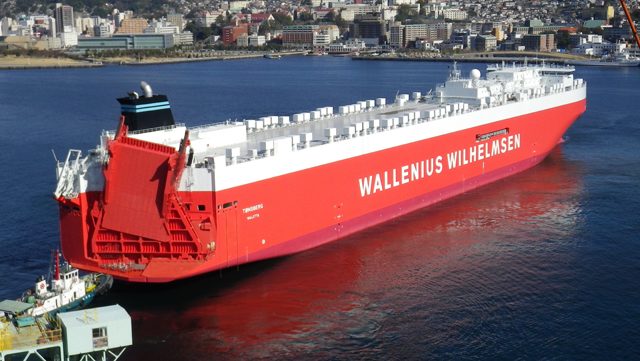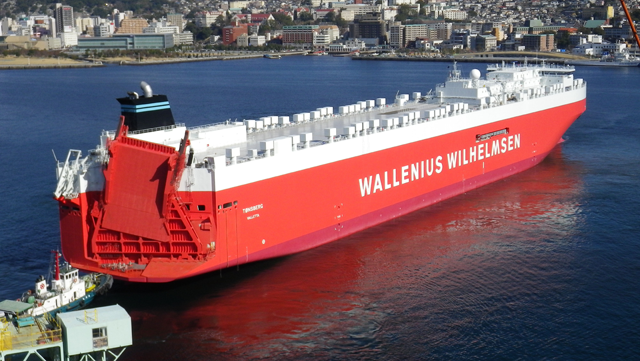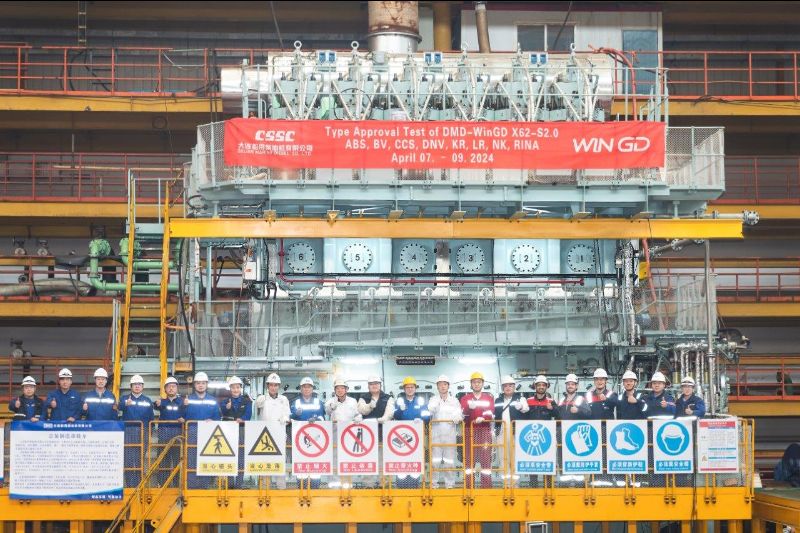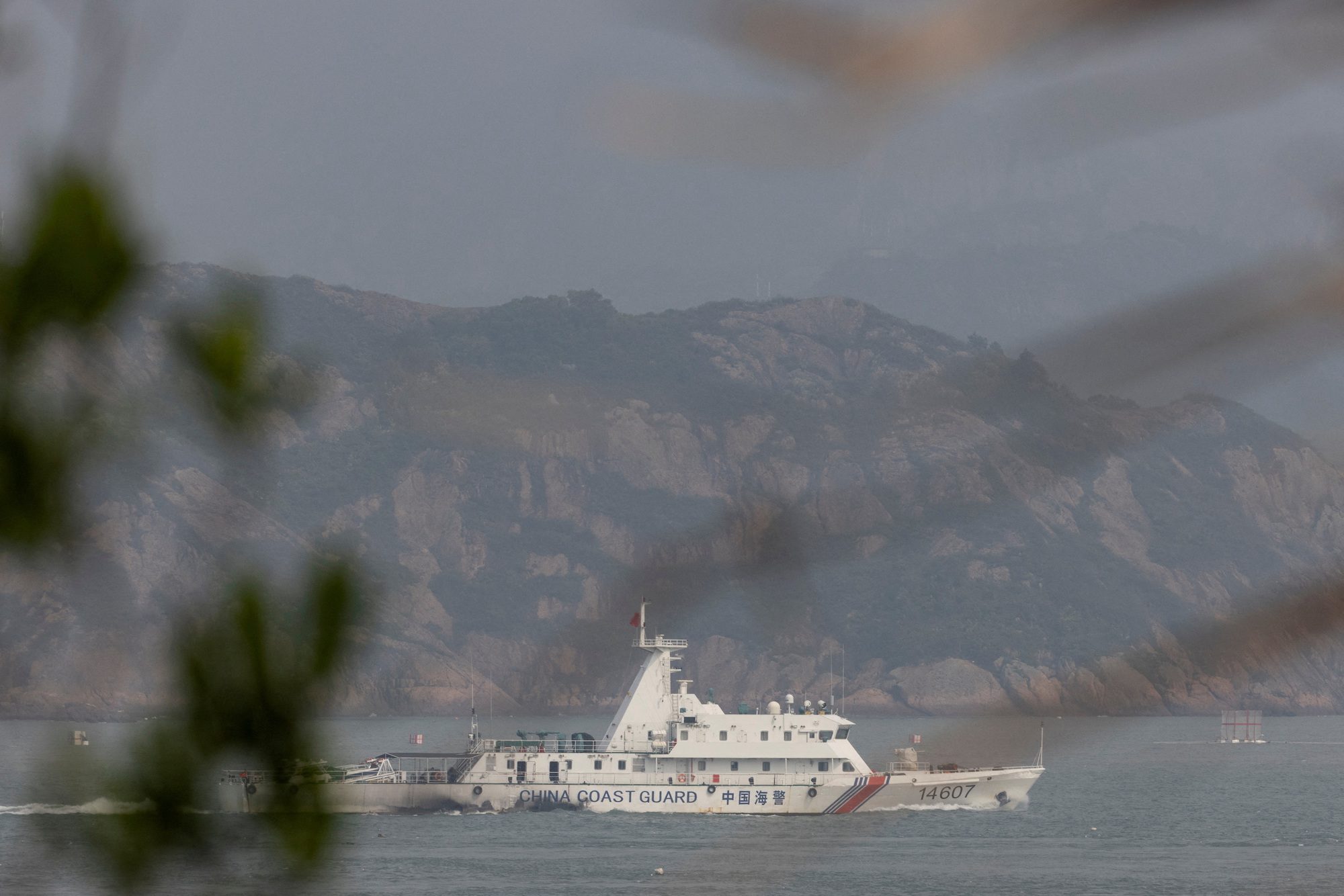

World’s Largest Car Carrier – The RoRo MV Tønsberg
Wilh. Wilhelmsen group made maritime history with four of the world’s largest RoRo car carrier ships ever built. As a first of the series, launched earlier in 2011, the DNV class MV Tønsberg also represented a 150th anniversary vessel for the Norwegian RoRo specialist. The Mark V class vessel is the largest of its kind, with a length of 862 feet offering a cargo volume of 138 000 cubic metres over six fixed and three hoistable decks.
“This ship is the result of thirty years of evolution. The MV Toba, the first of the Mark Series, was delivered in 1978 and even before this Wilhelmsen was innovating in the RoRo sector,” said Captain Alex Maresca, Site Manager for Wilhelmsen Marine Consultants. He added that the scale, sophistication and energy efficiency embedded in these ships represents the culmination of the company’s expertise in deepsea roll-on roll-off transport.
Captain Maresca, Swiss by birth but fluent in Norwegian, recounts how a boyhood trip to Norway inspired him to go to sea.
Captain Maresca has supervision responsibility for all four of these vessels, which mark the pinnacle of a career with Wilhelmsen that started in 1966 as a deck boy on a good old-fashioned liner the Tugela. His first RoRo, the MV Toba was actually one of the Mark I series. The year he joined the MV Toba in 1980 also holds special importance for him because this was the year that his son was born. The reference point of the Mark I is a yardstick on how far Captain Maresca and his employer Wilhelmsen have evolved. The four Mark V ships will be deployed to the company’s round-the-world service of today, a 110–120 days roundtrip from Europe to US East Coast, Oceania, South East Asia, Far East, US West Coast, US East Coast and across the Atlantic back to Europe.
To serve this demanding trade lane with the ultimate in flexibility, efficiency and dependability, the Mark V class stands alone as one of the most sophisticated RoRo vessels ever built in terms of high ramp capacity, deck strength and height.
“The ships are of impressive capability, but remember that they are designed to complement a highly complex and synchronized landside supply chain operation,” said Captain Maresca.
Wilhelmsen has traditionally developed and built their new generation ships in Japan together with Mitsubishi Heavy, and in this case with the layout design from in-house naval architects Wilhelmsen Marine Consultants working in collaboration with Mitsubishi Heavy. One of the shipyard’s specific contributions, amongst many, was the push for a six-blade propeller rather than a five-blade one, a decision that made the ship essentially vibration free.
There is a long history behind this relationship of owner, yard and class. The strength of the mutual commitment goes from the board rooms of Wilhelmsen, Mitsubishi Heavy and DNV down to where the welding torch meets the steel.
“When you walk around the yard, you recognize the same faces. That is quite reassuring when you are building a vessel of such precision and strength,” said Captain Maresca, noting that there is no room for compromise on the watertight ramp covers, alignment of decks and columns.
Captain Maresca has been involved in the supervision of ten PCTCs and the Mark V vessels, including contributing to some of the design features. Prior to the Mark V project, he was on site for the Mark II, Mark III and Mark IV in various capacities such as outfitting, painting and RoRo superintendent.
At the site in Nagasaki, Captain Maresca currently supervises six people, including the Secretary, Paint Inspector, Machinery Superintendent, Electrical Superintendent, Steel Superintendent and Site Manager. The machinery and electrical staff have many years experience in the RoRo trade. “Combined, we have more than 100 years of experience within the Wilh. Wilhelmsen company and most of this on RoRo vessels. Much of the credit for the good work, which has been done, has to go to these guys,” said Captain Maresca.
DNV has been working closely with Wilhelmsen in Oslo and in Japan, on many levels, with green and fuel-efficient strategies and concrete onboard solutions. This strategic top management level co-operation between Wilhelmsen and DNV was started a half a decade ago. One of the key issues was the determination of the performance goals for the Mark V. Some of the selected solutions to reach these ambitious goals were tested out on later ships in the Mark IV series.
“You really have to credit the Wilhelmsen Marine Consultants team, who have been involved in the design of the entire Mark series since the 1970s. We are really privileged to be on the receiving end of this design process, putting it into reality at the shipyard,” said Captain Maresca.
Four Mark V vessels will be delivered to Wilh. Wilhelmsen ASA and its partner Wallenius Lines. The second vessel will be delivered in August 2011 and the final two in 2012.
Wilh. Wilhelmsen ASA experienced a strong rebound in its shipping operations last year, with a 25% increase in transported volumes in 2010 compared with 2009.
The entire cargo hold of the Mark V is arranged for customers’ high and heavy cargo such as excavators, bulldozers, wheel loaders and harvesters. With a width of 12 metres and a safe working load of 505 tonnes, the vessel’s stern ramp offers customers the possibility of shipping larger units than they ever could before. Main Deck 4 has an entrance clearance of 7.4 metres with 25 metres of width, which is also unprecedented for this kind of vessel.
By moving the bridge forward, cargo can even be loaded on the weather deck, which has ramp access from the deck below. Three decks can be hoisted by electric winches to provide maximum flexibility and utilisation.
An optimised hull form together with streamlined rudder design and duck tail will allow the Mark V to consume 15 to 20% less fuel per transported unit compared to predecessors. In the engine room, an advanced turbo generator produces electricity from the waste exhaust heat. In total, these initiatives help to cut emissions significantly.
A Wilhelmsen Technical Solutions (the former Unitor) water ballast treatment system avoids harmful transfer of microorganisms to the sea. Furthermore, all fuel oil tanks are protected to minimise the risk of leakage in case of grounding or collision.
The first of the Mark V series is the MV Tønsberg, with the red coloured hull designating its ownership by the Wilhelmsen fleet. The second of the Mark V series, which is also at the quayside in the Nagasaki dock, sports the Wallenius green.


Such demanding routing requires a robust optimum hull shape for balance of stability and low resistance. The other key design goals are efficient and safe cargo handling together with minimum environmental impact.
All hoistable decks – Decks 4B, 6 and 8 – are to be operated by electric winches with the absence of hydraulic systems resulting in zero oil leakage. Hoistable decks nos 6 and 8 are to be constructed with plywood top plating in a steel frame to save weight.
It is no surprise that with the above characteristics the ship is built to the standards of the yet-to-be-ratified Hong Kong International Convention for the Safe and Environmentally Sound Recycling of Ships, 2009. DNV has reviewed and issued a “Statement of Compliance for Inventory of Hazardous Materials,” which is known by the industry shorthand of Green Passport and is essentially an inventory of all materials potentially hazardous to human health or the environment, used in the construction of a ship.
The Turbo Generator system is estimated to cut the total fuel annual consumption by about 5–6%, while CO2, SOx and emissions of particles (PM) will fall proportionally and NOx emissions by about 3%. All fuel oil tanks shall be protected against grounding and collision. Potential leakage from hydraulic cylinders for some of the heavy ramps (which don’t use all electric) shall be collected in drip trays as far as is possible.
“This ship is as close to handcrafted as you can be in the modern shipbuilding era. The features of such ships require nothing less than the closest partnerships with the shipyard and class. The results are proof of the commitment of all parties,” concluded Captain Maresca.
Originally published by Matthew Flynn for DNV’s Special Ships publication.
Related Video
http://www.youtube.com/watch?v=Z5KRbQmF7E4
Unlock Exclusive Insights Today!
Join the gCaptain Club for curated content, insider opinions, and vibrant community discussions.
Be the First
to Know


Join the 108,764 members that receive our newsletter.
Have a news tip? Let us know.



 Join The Club
Join The Club









